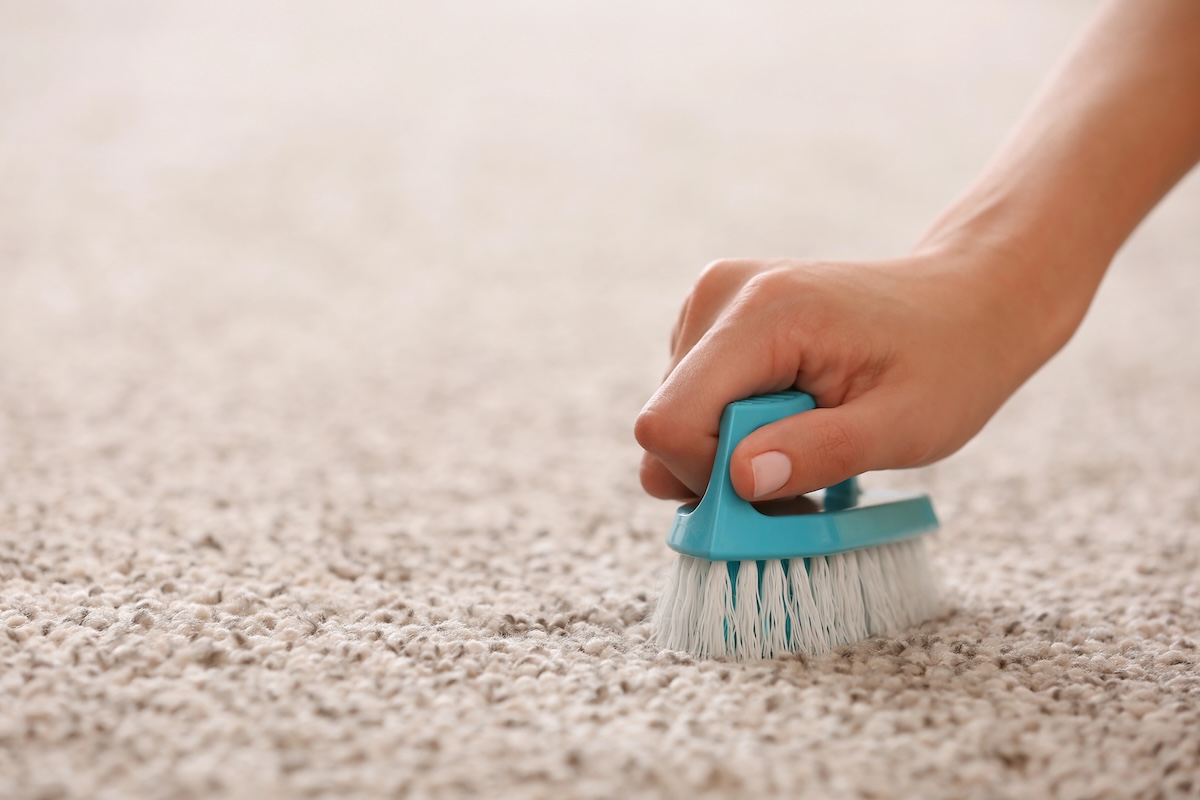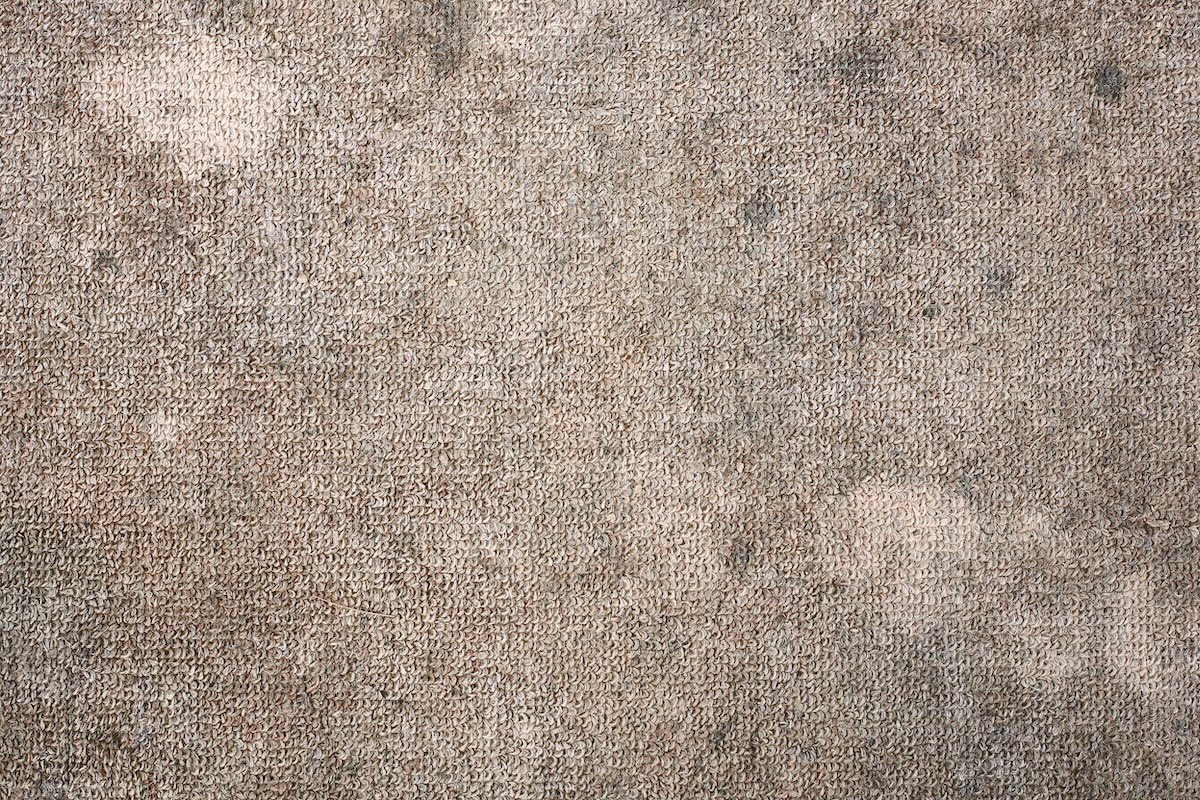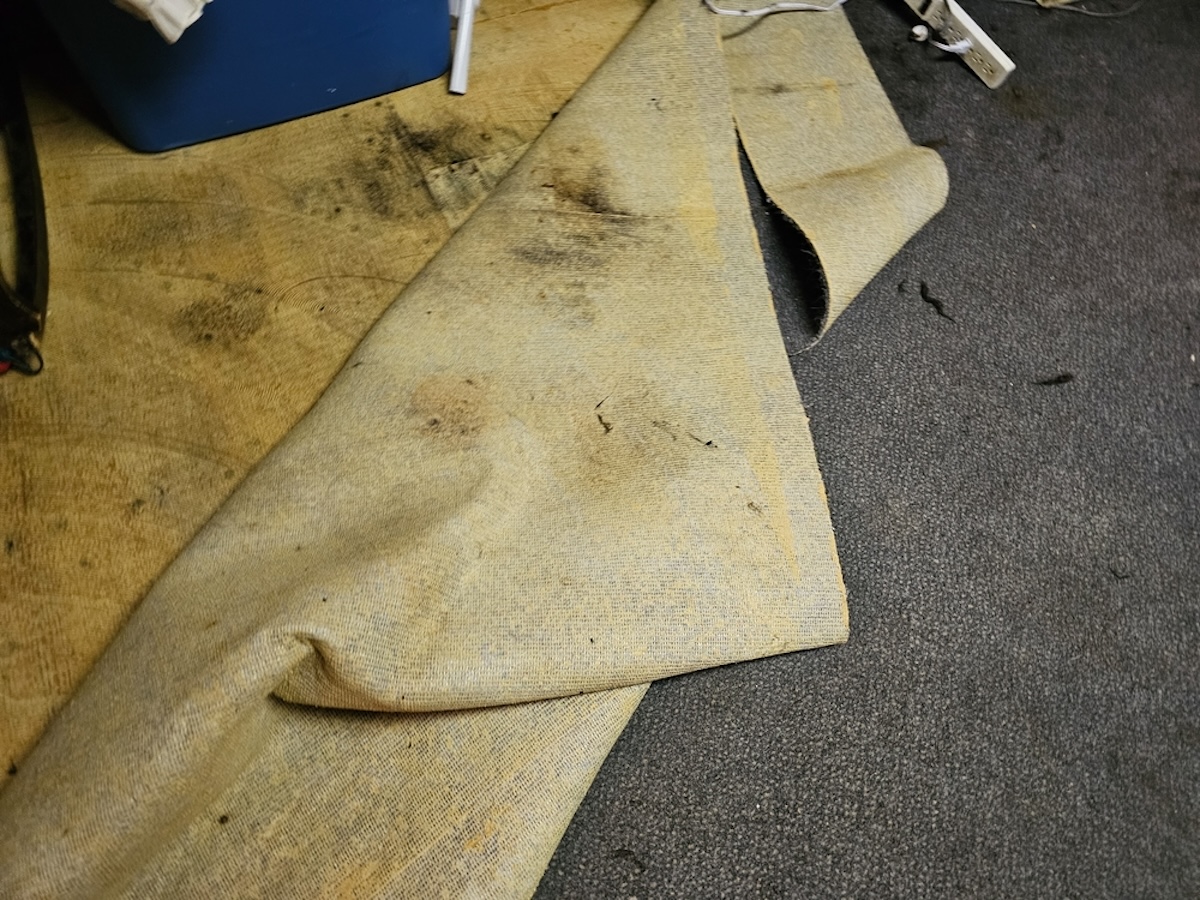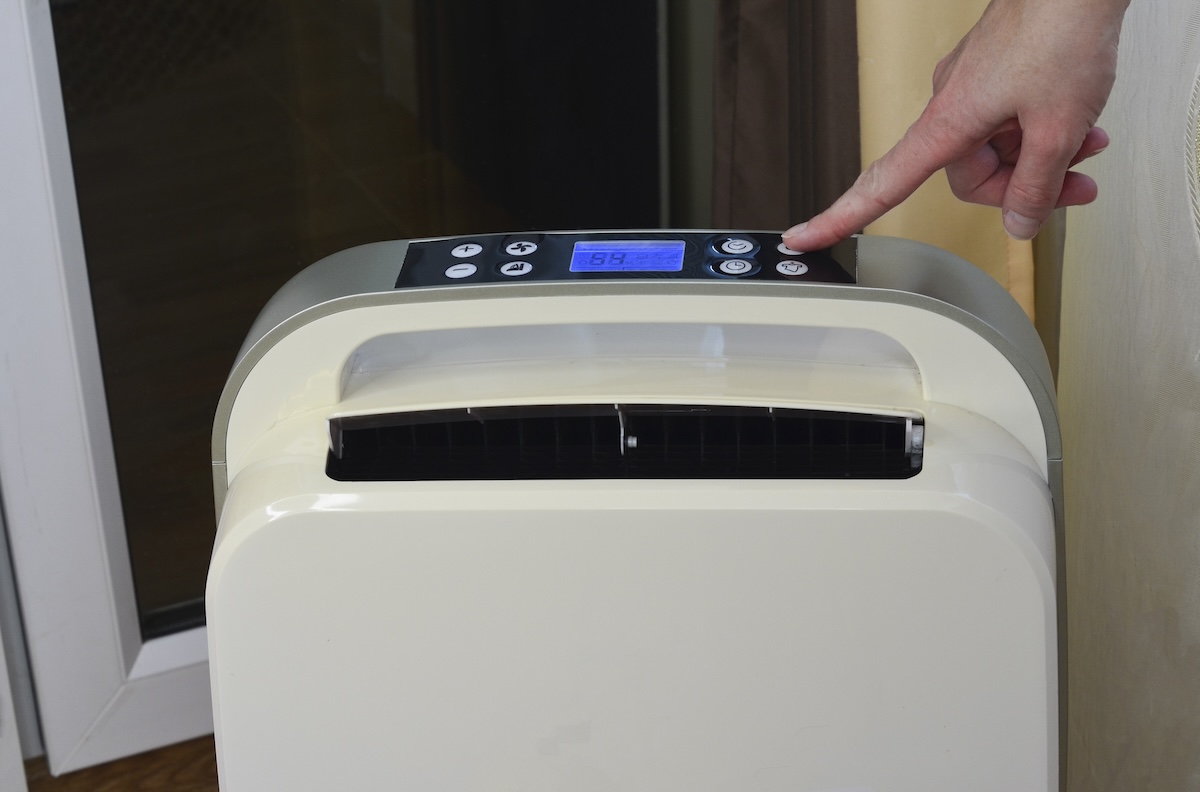

We may earn revenue from the products available on this page and participate in affiliate programs. Learn More ›
Mold is a living, growing organism—a type of fungus—that thrives in damp environments. On carpet, mold can show up as green, gray, black, or white patches, and it can add a strong musty odor to a room. Mold can lead to chronic allergies, asthma, and even bronchitis.
While you may be able to mitigate smaller areas of mold yourself, sections that are more than 5 feet wide require professional treatment. In these cases, the mold has likely seeped into the underlayment or flooring, which makes it much harder to treat or remove.
While it’s important to determine how to get rid of mold in carpet, it’s equally important to eliminate its root cause: moisture. When you tackle the carpet mold, you must at the same time resolve any water issues, such as leaks or groundwater seepage, or the mold will return.
Why Does Mold Grow on Carpet?
Moldy carpets are primarily caused by persistent moisture, whether it’s the result of a plumbing leak, overzealous watering, or a not-quite-house-trained puppy. Mold can grow in surprising places, but carpets are ideal environments for mold because they retain moisture, and the dust and dirt they trap provide food for mold.
Moldy carpet can also be caused or made worse by:
- Poor ventilation in the surrounding area
- Organic matter accumulation
- Flooding
- Improper cleaning
- Structural issues
If moisture is consistently present, a carpet can experience mold growth in a matter of days. “Moisture must be considerable and sustained for a period of time” to produce mold, says David Ragsdale, production manager at ServPro, a cleanup and restoration company. “The period of time is driven by many factors, but primarily by the types of mold spores present and environmental conditions like temperature, airflow, and humidity.”
Whatever the cause and contributing factors, it’s critical to resolve moldy carpet issues promptly.
Signs of Mold in and Under Carpet
Recognizing the signs of mold in or under carpeting is crucial so you can address the issue promptly and prevent further damage or health hazards. “Sometimes there may or may not be a musty odor associated with the carpet,” explains Neil Carlson, an industrial hygienist at the Health, Safety, and Risk Management department at the University of Minnesota. The odor “is more likely when the carpet is still damp, or in a location with higher equilibrium relative humidity.”
The most common signs of mold are:
- Visible discoloration
- Damp carpet
- Lifted carpet
- Water damage
- A strong, musty smell
Health Risks of Mold in Your Home
The severity of mold’s health effects varies depending on the individual, the type of mold, and the degree of infestation. Some people may not be affected at all, while others may have unpleasant—and in some cases serious—reactions.
Those who are sensitive to mold exposure may experience sneezing, stuffy nose, wheezing, or red, itchy eyes or skin. Mold can trigger asthma symptoms in asthma sufferers as well as much more severe reactions, including fungal infections, in people with compromised immune systems. Early mold exposure has been linked to the development of asthma in some children.
If you have moldy carpeting it’s important to remove the mold and take steps to prevent it from returning, even if no one in your household is experiencing health effects.
Project Overview
Working Time: 3 to 10 hours
Total Time: 3 hours to 3 days, depending on the extent of mold growth
Skill Level: Intermediate
Estimated Cost: $245 to $2,500
Safety Tips for Working With Mold
Mold is spread via microscopic airborne spores, so before you start cleaning moldy carpet, put on a long-sleeved shirt, long pants, and protective gear. If you have allergies, asthma, or a weakened immune system, leave the job to the pros or someone less susceptible to mold’s health effects.
As Carlson recommends, “It is best to follow the [Institute of Inspection Cleaning and Restoration Certification] IICRC-520 guidelines for the removal of porous material with fungal contamination.” Because mold removal increases the level of fungal spores in the air, Carlson suggests using HEPA-filtered respiratory protection.
Tools & Materials
Bobvila.com may earn a commission from purchases made through these links.
How to Get Mold Out of Carpet

Whatever the cause of the problem, removing mold from carpet requires quick and effective action. Here’s how to clean moldy carpet, even one harboring black mold (Stachybotrys chartarum), safely and thoroughly.
Step 1: Ventilate the area.
Open windows to ventilate the space. Put on a long-sleeve shirt and long pants, and use (at least) an N95 respirator mask, eye protection, and disposable gloves.
Step 2: Determine the extent of the problem.
If possible, lift the carpet and examine the backing and the floor or padding underneath to check for mold. (Moldy padding should always be discarded.) If you can, you may want to remove the carpet and treat it outside. Otherwise, plan on cleaning all accessible moldy surfaces in position.
Step 3: Scrub the affected surface.
Scrub moldy surfaces with a dry stiff-bristle brush to remove mold from the carpet. If you can access the back of the carpet and the area beneath the carpet, scrub it too. Brush any loose mold into a dustpan and discard it in a trash bag. When you’re done, tightly tie the bag and dispose of it outside.
Unless you own a HEPA vacuum, vacuuming is not recommended, as spores on your vacuum can be spread to other areas in your home. If you do use a HEPA vacuum, when you’re done, take it outside to remove the bag and filter. Seal them in a plastic bag before putting them in the trash.
Step 4: Treat the area with an antifungal spray.
Thoroughly saturate the moldy area, and at least 6 inches around it, with an antifungal spray that specifies that it’s safe for carpets. Some products will also provide a mold barrier or mold protection. Spray both the front and back of the carpet, if accessible, as well as the floor/underlayment beneath. Let it sit according to the product’s instructions, typically an hour.
If you’re wondering how to get mold out of carpet naturally, white distilled vinegar is an effective mold killer, but it’s less effective on porous surfaces like carpeting. To use vinegar to treat moldy carpet, spray a 1:1 solution of water and vinegar on the moldy area, scrub it with a brush, and then wait about an hour. When the carpet is dry, vacuum thoroughly.
Step 5: Blot excess spray and dry the area.
Blot the antifungal spray with a dry, clean, disposable rag to soak up excess. Do not rinse; the antifungal agent will continue to work until it has fully dried.
- To avoid spreading mold spores, don’t use a fan to accelerate drying.
- Close the windows and, if possible, turn up the heat in the room.
- Let the carpet dry naturally for at least 24 hours.
- Use a dehumidifier in the room.
- Don’t walk in the area or let pets into the room while the carpet is drying. The mold spores are still present and can potentially be spread.
Step 6: Clean tools and dispose of contaminants.
Clean the brush and dustpan by scrubbing with hot soapy water and then spraying with antifungal treatment. Let them dry completely. Dispose of the rags and rubber gloves in a trash bag and seal it tightly.
Step 7: Repeat the process.
Once the carpet has dried thoroughly, reapply the antifungal spray, repeating Steps 4 through 6, using the cleaned brush and dustpan and clean disposable rags. As before, dispose of the used rags, tightly sealing the garbage bag. Run the dehumidifier for a few more days to dry out the surfaces. Consider investing in an air purifier to remove mold spores from the air.
Make sure you have eliminated the moisture problem that led to the mold growth in the first place, and continue checking the area every day or so for a few weeks. Especially if you were not able to lift or remove the carpet, mold may creep back. If your initial attempt at mold removal didn’t succeed, or if the mold returns after a while, call in a pro to treat and clean the carpet.
When to Replace Moldy Carpet

If the mold has taken over a larger area and is beyond the scope of DIY cleaning, replacing the carpet may be the best solution. “If the water has additional contamination or has been on the carpet for more than 48 hours, then removal vs. extraction and cleaning is a 50/50 decision,” says Carlson. “If the water is a category 3, such as sewer backup, overland flood water, or heavy rainstorm water, then removal with containment and good hygiene is the best approach. The remaining surfaces will need to be disinfected with an EPA-approved cleaning agent.”
According to Carlson, these are some of the signs that the mold may be too old or extensive to clean up on your own:
- Visible mold growth on the carpet
- Deeply embedded mold
- A strong, musty odor
- Water damage beneath the carpet
- Water damage that has not dried out thoroughly in 48 to 60 hours
- Health issues (allergies or respiratory symptoms)
Additionally, carpet backing with substantial mold growth of more than a few feet in width should not be merely cleaned—you’ll need to replace the carpet.
If the cost of replacing a room’s worth of carpeting is too steep for your budget, you can opt to cut off the moldy area, plus a 12-inch border past the damage, and insert a carpet patch. This is probably not the best solution for a spot in the middle of your living room, but it might work if the affected carpeting is in an out-of-the-way area of the room. Be sure to remove and replace any moldy underlayment or padding as well to thwart mold’s return.
Tips for Preventing Mold on Carpets

By implementing proactive measures, you can minimize the risk of mold forming in your space and prolong the life of your carpet. Here are some effective ways to help keep mold at bay:
- Consistent cleaning: Vacuum regularly, deal with spills and leaks promptly, and open windows and run fans to dry out damp carpet quickly.
- If you use a carpet cleaner, use the machine as directed and allow adequate drying time.
- Don’t set plants in clay pots directly on the carpet, not even with a water tray underneath. Use only glazed pots, not terra-cotta, on carpeting, and lay down a moisture barrier such as a rubber tray or mat.
- Never pile firewood on the carpet. Always have a moisture barrier between the wood and the carpet.
- If your pet has relieved itself in an area more than once, speak to your local pet store about deterrent sprays that can make the spot less appealing.
In humid seasons or humid rooms, run a high-quality dehumidifier to keep moisture to a minimum. This will protect hardwood flooring and artwork as well as carpeting.
FAQ
The most effective way to kill mold in carpet is to treat the mold with an antifungal product. Distilled white vinegar can also kill mold, but it is less effective on porous surfaces like carpets and is unlikely to kill all of the mold. While other common household cleaners like baking soda, bleach, and hydrogen peroxide can kill mold, they’re not effective on porous materials, and hydrogen peroxide and bleach can discolor carpets.
If there’s visible mold on a small area of carpet, you may be able to clean it, assuming you also correct the moisture problem that caused the mold to grow. For larger infestations, call in a professional carpet cleaner or replace the carpet.
Yes, a moldy carpet can make you feel ill, although not everyone will experience the same symptoms. Exposure to mold can cause coughing or wheezing, runny nose, burning eyes, or skin rash. Those who are allergic to mold may have more severe reactions, and people who are immunocompromised can develop lung infections.
You spend many hours asleep—and that’s a lot of time to be inhaling mold spores. Even if you do not have a significant reaction to mold, you should treat or replace a moldy carpet in a bedroom or other sleeping area. In short, if you can see or smell mold in any room, get rid of it.
To kill mold on carpet, spray on a 1:1 solution of water and distilled white vinegar, scrub the carpet, and let it sit for about an hour. Vacuum when dry. Note that vinegar is not as effective on porous materials like carpet as it is on nonporous surfaces. Even after treatment, the mold may persist.
